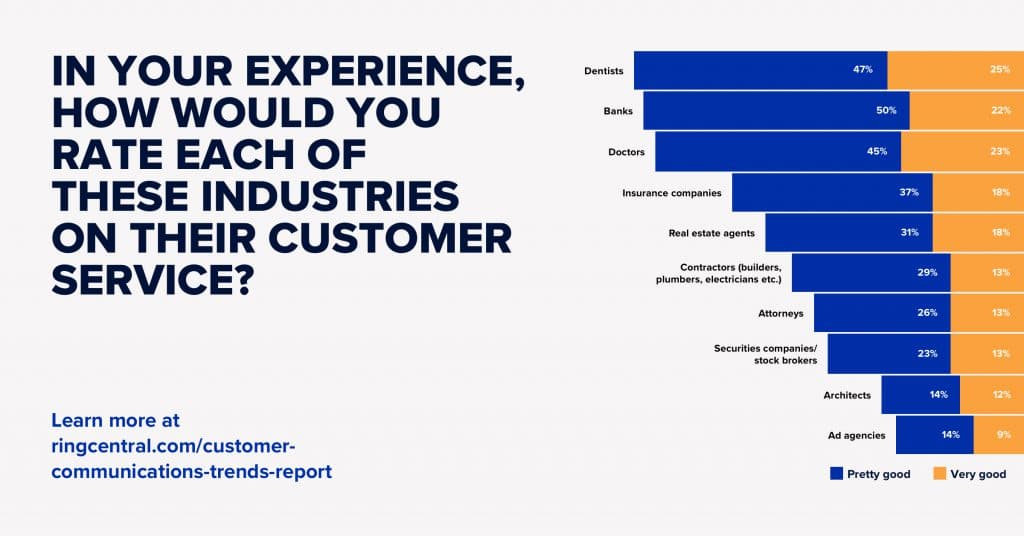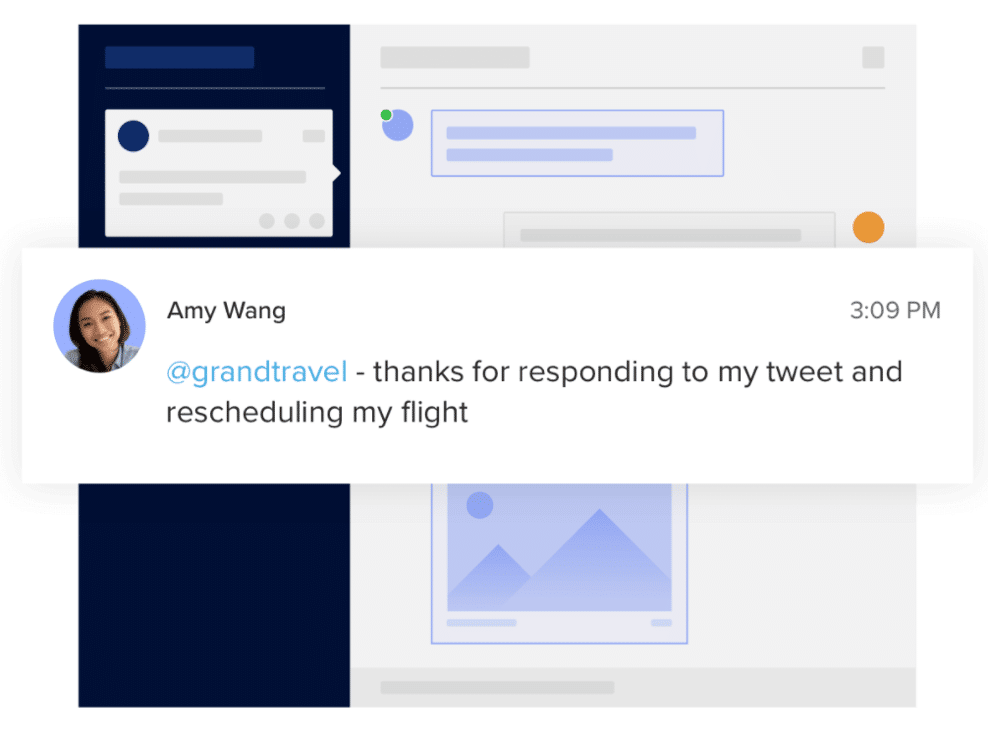If there’s one thing most business owners can agree on, it’s that they need to get a little creative with their customer service.
That’s because customers are in control—now more than ever. They have more ways to reach companies, buy products or services, and share their experiences with others.
If you can provide them with a superior level of service at every touchpoint, you can elevate the customer experience (and enjoy higher customer retention rates).
Small businesses especially stand to gain by implementing best practices for customer service (we’ll get more into this below.) When customers always seem to be one experience away from leaving you for another company, great customer service can really serve as a buffer and set you apart.
One survey by Gladly found that almost 70% of consumers claim they are willing to spend more with companies that are known to provide good customer service experiences1. In other words, improving your customer service is a win-win for everyone involved.
In this article, we’ll look at:
- Why it’s important to have best practices in customer service
- 4 online customer service best practices
- 3 in-person customer service best practices
- 3 call center customer service best practices
⭐️⭐️⭐️⭐️⭐️ Ready to offer 5-star customer service? Get strategies for every stage of the customer journey with this free eBook.
Why should you have customer service best practices?
Customer expectations have evolved significantly over the years. For some industries in a positive way, and for others… not so much:
Gone are the days when it was acceptable for customers to have limited choices when they needed help or inquired about a product or service. Today’s customers want instant gratification and convenience whether they’re getting in touch with you via social media, email or an old-fashioned phone call—and they want it without any restrictions or delays.
Think about your own expectations. If you complain about a product on social media, for instance, you expect the relevant company to respond right away and even offer a specific solution. The moment your expectations aren’t met, you walk away and choose another business. (Yup, those repeat sales are not accidental, and without a positive customer experience, money will go somewhere else.)
The good news is that as a business owner, you have the ability to deliver stellar experiences—by following customer service best practices on mediums people regularly use to connect with your company. Doing this gives you many benefits:
- Word-of-mouth referrals: When a customer receives an exceptional service, they are likely to share their experience with family and friends, which results in great publicity.
- Increased customer retention and loyalty: Treating customers with integrity and respect helps you build a relationship that makes them reluctant to take their business elsewhere.
- Differentiation: One of the hidden benefits of great service is that by providing an unforgettable customer experience, you can differentiate yourself as a company that values people’s opinions.
Now, let’s look at a few ways to improve customer service and make sure you’re laying the foundation for long-term success.
But instead of sharing a list of general pointers, we’re going to break down customer service best practices by the typical ways people interact with small businesses.
[ebook-download title=”How customer-obsessed is your business?” link=”https://netstorage.ringcentral.com/documents/quiz_how_customer_obsessed_your_business.pdf” cta-text=”Take the quiz” src=””]
4 online customer service best practices
1. Meet customers on their channel of choice
Customers want their experience with your business to match the rest of their life.
Just as they can watch shows on demand on Netflix or instantaneously message friends on WhatsApp, they expect your customer support to be equally on demand.
This makes it crucial to have an omnichannel engagement strategy (or at the very least, omnichannel customer service) in place so that you never miss an opportunity to create a better online customer experience.
For instance, sometimes a customer may ask you a question on Instagram, but they may still prefer to use live chat for the majority of their queries.
That’s why your business should have a tool that lets you connect with your customers on all these different channels—ideally, in the same platform so that you don’t have to jump back and forth between customer service apps and windows.
For example, RingCentral Engage Digital™ lets you do this, and it even allocates resources to make sure your conversations are all tracked. This helps you improve your first contact resolution standard and have context for future conversations:
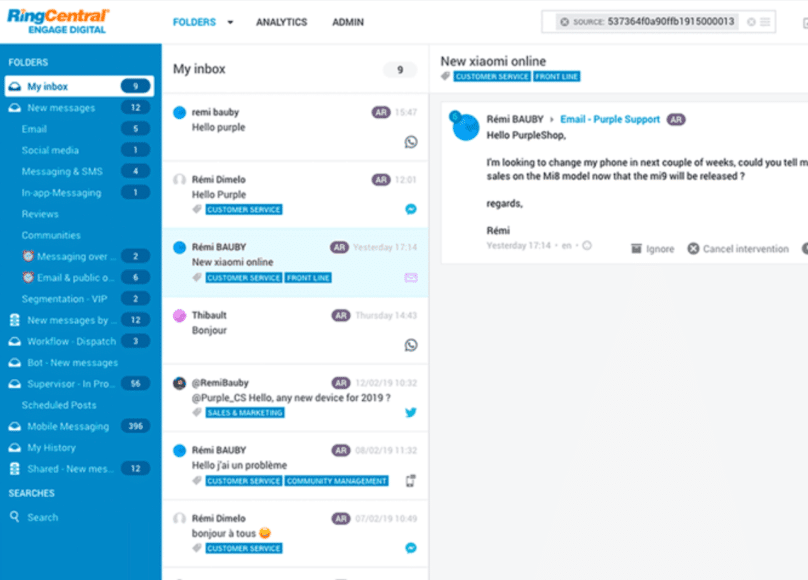
RingCentral Engage Digital lets you interact with customers on their channel of choice—all in one window.
To give a real-world example, French pay-tv provider Canal+ used RingCentral Engage Digital to streamline customer interactions. With different Facebook pages and a website, the company found it critical to bring customer queries under control.
RingCentral’s solution enabled the company to encourage use of chat, email, and other social channels for customer service while allowing both outsourced and in-house teams to manage these channels effectively. The result is that Canal+ is now able to answer 98% of queries and meet customers on their channel of choice. If you’re interested, you can read the full case study here—or check out this quick clip to see how it works:
2. Personalize interactions
In one study by Epsilon, a whopping 80% of consumers2 said that they’re more likely to buy from businesses that offer a personalized experience.
The good news? There are countless ways to personalize a customer’s experience.
For example, one simple communication technique is to make sure to use your customers’ names in your conversations with them, whether that’s live chat or an email:
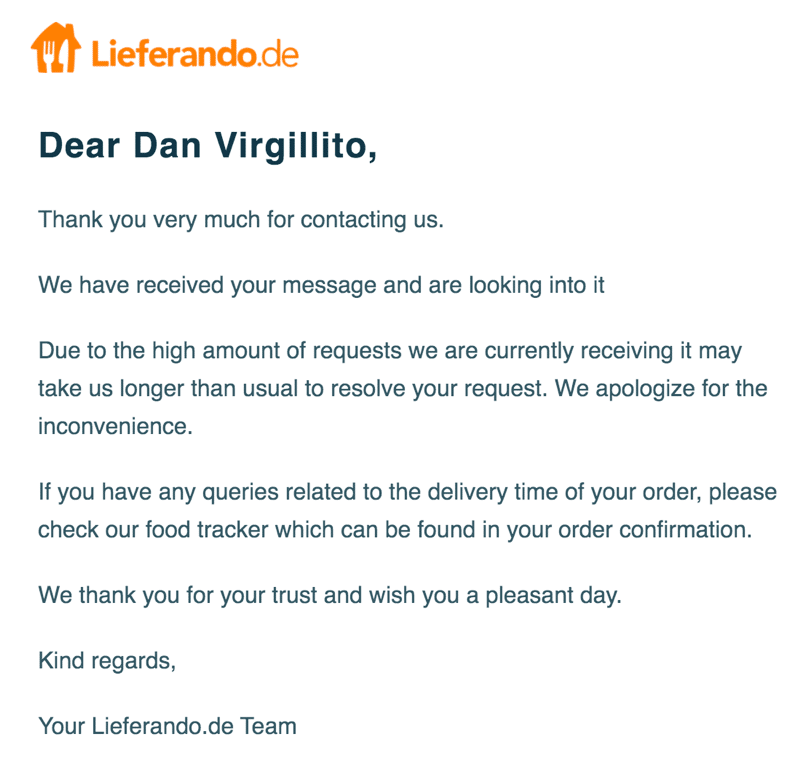
You can also get creative and think outside the box when interacting with customers. This works particularly well for businesses that operate in industries not known for having a sense of humor.
A witty response can make people rally around your company and create a fun chain of engagement (although if the request is a serious one and your customer is legitimately upset, you should probably avoid this approach):
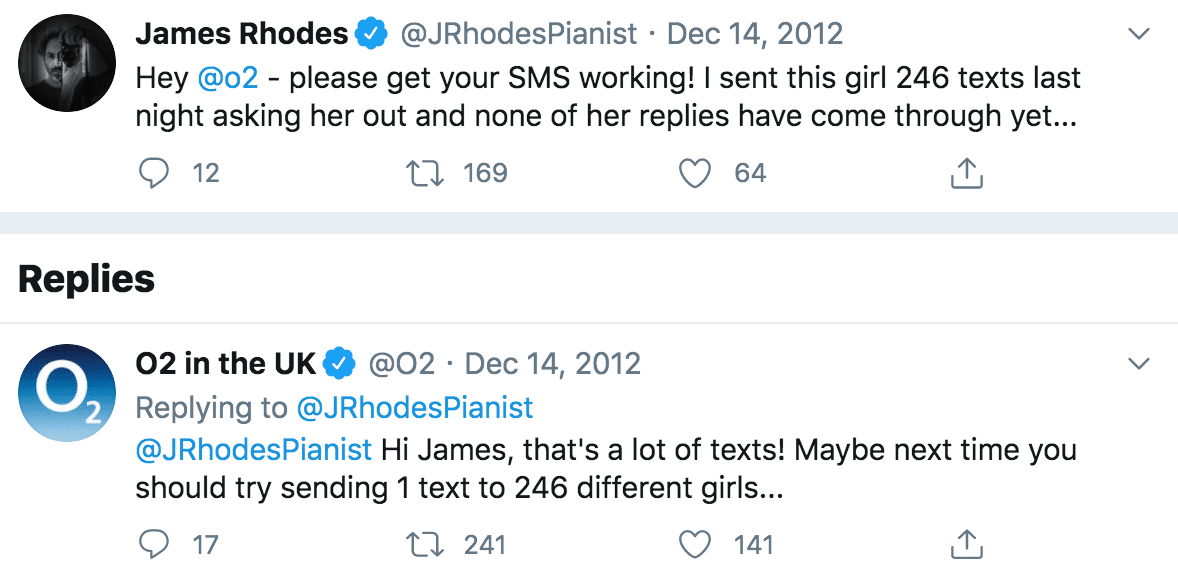
If you have access to other useful tidbits like what your customers are looking to achieve with your company, use that information to personalize your customer service.
For instance, a fitness trainer who’s familiar with their clients’ goals can put a recurring note on their calendar to remind the clients of their objectives and evaluate their progress.
3. Offer different self-help options
Self-service is quickly becoming the preferred option for customer service.
That’s because it provides your customers with immediate solutions that they can access in their own time.
It also reduces the burnout from repetitive routine requests and gives you and your team more time to solve more complex or unique customer issues.
Here are some popular self-service options that you can offer to your customers:
- Product training: Create tutorials where you demonstrate how your product or service is used. This can be done with the help of videos that you can publish on your website, blog, and social media pages:

- FAQs: This one’s easy. Write down the answers to the most common questions people ask and publish them on your website. Make them easy to find by adding a menu for them on the site’s homepage:
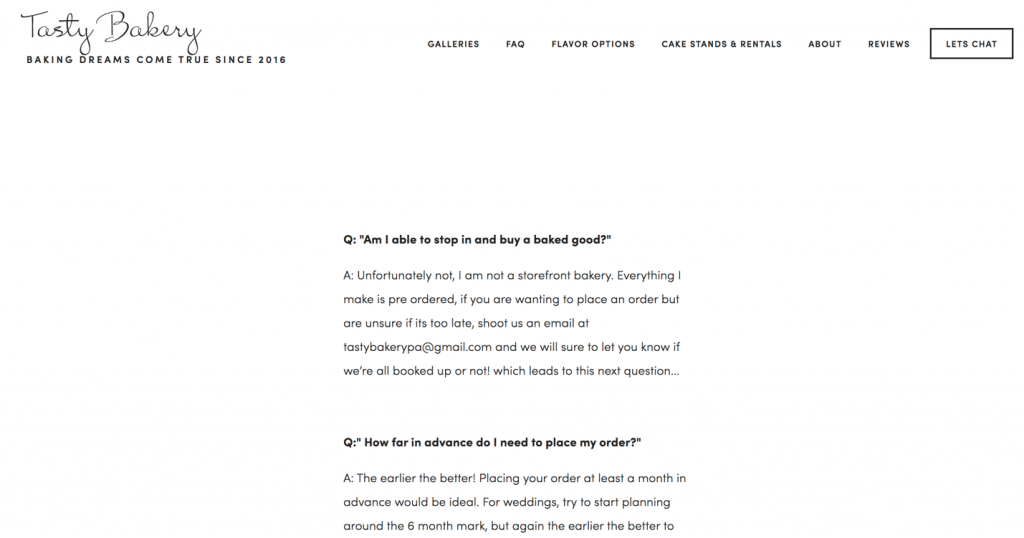
- Chatbots: Use tools like Chatfuel to set up a bot that provides customers with initial solutions. Interact with the bot frequently so that it learns how to respond to questions about your business correctly:
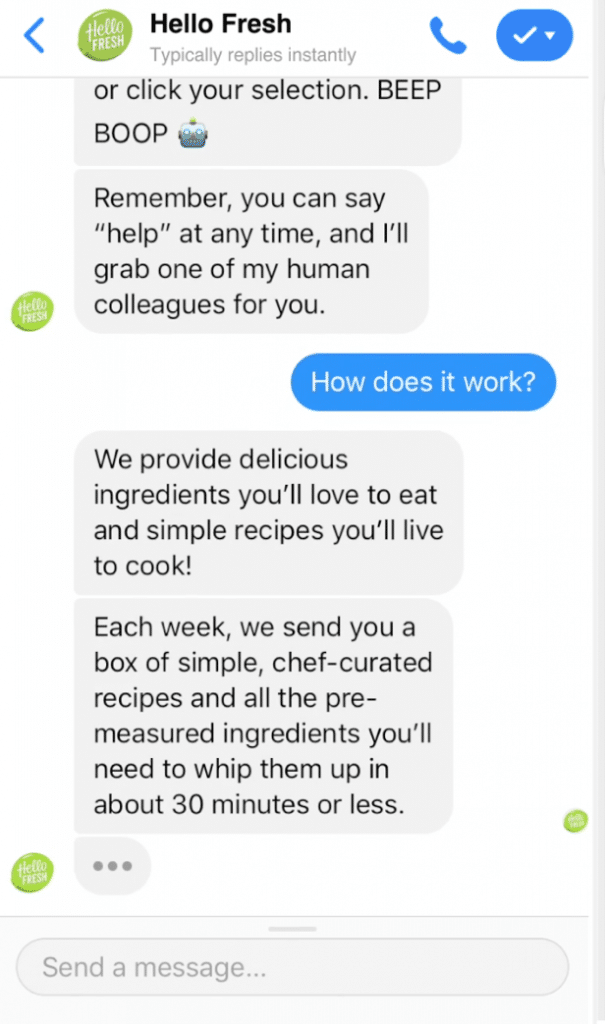
4. Tailor messaging to different generations
With generational tension at an all-time high, it’s important for customer service to get their message across the right way.
In order to do this, you have to respect and cater to the communication preferences of each generation.
For example, Boomers might take to the phone or comment on a Facebook post with an order issue, while millennials and Gen Z might ask for help through WhatsApp, chat, email, SMS, and even video conferencing.
Tailor your messaging to each audience by creating a separate communications strategy for every demographic cohort you serve.
But regardless of which cohort you’re talking to, you should be providing a seamless customer service experience on all your channels. Having a unified communications solution can make it way easier to provide a better experience (everyone has access to the same information so that the customer doesn’t have to keep answering the same questions if they get handed off to different reps), no matter which communication channel your customers prefer.
RingCentral, for instance, lets you consolidate your presence on virtually any digital and social channel your customers are using. This makes sure your customers’ questions are answered right the first time—and fast:
RingCentral lets you aggregate messages from all channels to streamline customer service.
3 in-person customer service best practices
1. Collect and incorporate customer feedback
There’s no better way to show your customer that you’re listening to them than by asking their opinion and then actually following through on it.
Plus, collecting customer feedback is a form of “market research” that helps you better understand your audience in general. When you hear multiple people asking for the same thing, it means that you better jump on it!
Listening to your audience is the absolute best way to improve your business and to get a leg up on your competitors.
Here are a few ways that you can collect and incorporate customer feedback:
- Online survey: Use a QR code or have a short URL you can direct people to, and incentivize them to fill out the customer survey in-person by offering a discount or a special treat.
- Survey kiosk: If you have the cash to invest upfront, you can put a survey kiosk inside your shop or customer service area. It can be as simple as having an iPad set up. This way, the customer doesn’t have to pull anything up on their phone to give you that golden feedback.
- The classic suggestion box: If you don’t want to use any tech-based collection tools, good old-fashioned pen and paper will still work just fine:
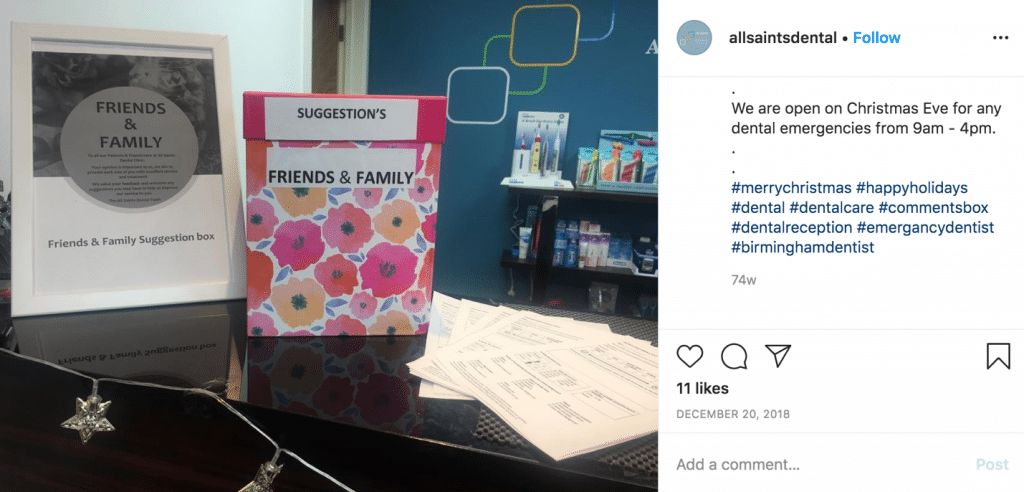
2. Encourage people to step out of their comfort zone
How many times have you stood there in an aisle or at the checkout counter, staring at the basic and the premium option for a product?
Maybe you even had a brief fantasy about how amazing it would be to go for the premium option, but immediately felt a pang of guilt or discomfort for even thinking about it.
If you want to create a good customer experience, be there for your customers and encourage them to take a little risk when the situation calls for it. Show them that it’s okay to spend a little extra on themselves if the upgrade is truly a better fit for their lifestyle and long-term comfort or happiness levels.
And of course, there’s a delicious bonus here: in addition to making your customers feel good about their own decisions (and themselves by extension) and building a better relationship with them, you’re also nailing the upsell.
That’s yet another example of a win-win situation.
3. Give them freebies—for no particular reason
Think back to how many people you’ve heard rant and rave about good customer service. Now think about how many times that involved the company footing the bill for a replacement or repair, or giving them a freebie or gift that they weren’t expecting?
Probably a lot.
Go the extra mile by pampering your customers with little extras. It doesn’t need to be a big investment—it can just be small, thoughtful things:
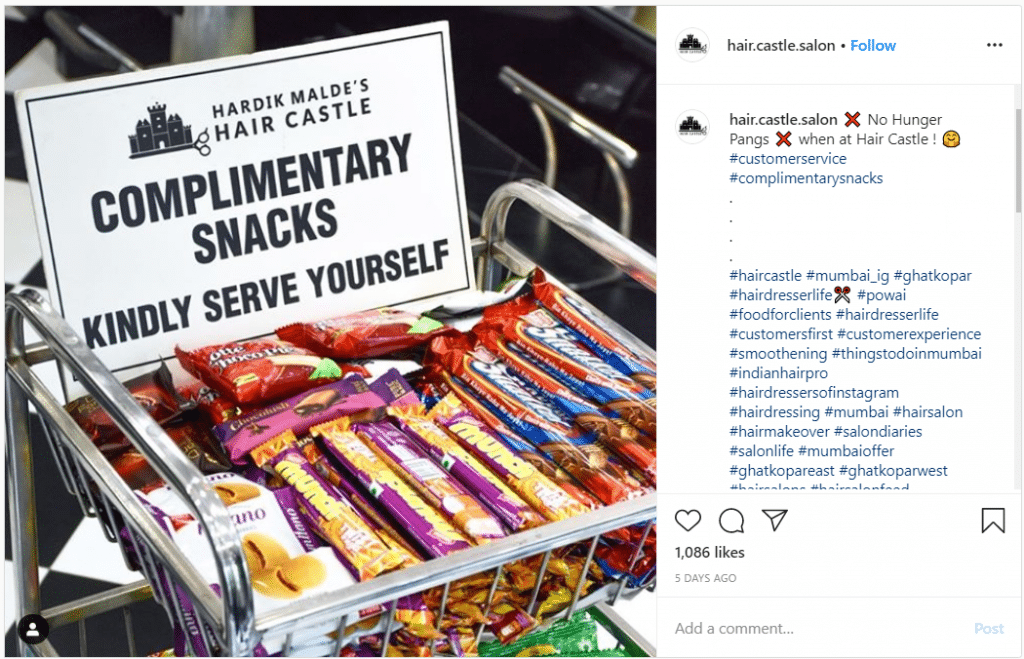
If you’re a food vendor, try giving samples of your delicacies. If you’re a massage parlor, offer a small aromatherapy candle or body lotion samples.
You can get creative. At the end of the day, it doesn’t really matter what you give for free—people will just appreciate that you thought about them.
3 call center customer service best practices
1. Create a great on-hold experience
Putting customers on hold is unavoidable for many businesses, but that doesn’t mean it has to be a frustrating experience. A memorable message can help keep them both informed and entertained.
In one case study, Venue On Hold found an informative on-hold message leads to a 40% increase in retention of callers and a 12% increase in requests for items mentioned in the message.
Don’t miss out on an opportunity to educate and convert your callers. Here are a few ideas for using on-hold messages to improve the customer experience and get engagement simultaneously.
- Share a success story: Consider delivering a heartfelt testimonial as a brief story to engage and retain callers.
- Use the element of surprise: Introduce a really interesting fact about your business that might raise an eyebrow or two.
- Upsell a product or service: Tell customers about your entire range and how they can take advantage of savings by purchasing bundles instead of individual products.
2. Make customers fall in love with your IVR menu
To improve the customer experience with your interactive voice response (IVR), don’t play the guessing game.
Build out your automated menu based on the questions you know people are asking, and create the most logical flow based on the available solutions. (Learn more about automated customer service.)
For example, you can tell the customers to press 1 for general requests and configure the IVR to connect them with any employee in your company.
For technical queries, they can be asked to press 2 and the IVR can take them to the second layer of the menu, where they can choose from a list of problems and get connected to someone with IT skills.
This is a good time to think of your own interactions with IVR. What did you love about the automated phone system you’ve used as a customer? What drove you nuts? Your IVR should be a tool that makes people’s lives easier, so make sure you design a menu that is clear and simple for anyone who calls:
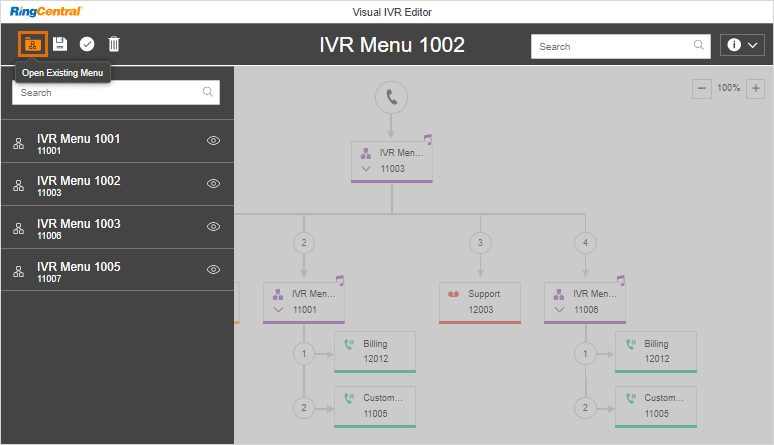
For example, RingCentral offers IVR tools to configure automated menus, including an easy-to-use IVR editor to add/manage options on the fly.
3. Use post-call surveys
One of the best ways to get a feel of the customer experience is by offering short surveys at the end of each call.
Using this approach, you can learn whether or not the customer’s issue was resolved, if they’re satisfied with your service, and if they’d recommend your business to others based on their existing experience.
If you’re going to use surveys, you should be ready to incorporate customer feedback. Doing this will show your customers that you’re listening to their concerns and that you want them to succeed.
By prioritizing issues, addressing the top complaints and tackling the biggest gaps, you’ll see an immediate improvement in your call center customer service experience.
Supercharge your business with these customer service best practices
In today’s fast-paced economy, people have high customer service expectations. Meeting and exceeding these expectations starts with offering a seamless experience across support channels. When you can deliver your message and serve customers across all platforms, your business is able to grow its visibility amongst a much larger audience in a short span of time.
And if you want them to stay with you long-term and refer your business to their colleagues and friends? Well, it takes a little more work. From the self-help options you provide to the feedback you gather and incorporate, everything has an impact on the customer experience.
So, invest time in shaping your business and make sure you’re implementing these customer service best practices at every turn to attract, engage, and delight audiences.
Originally published Mar 30, 2020, updated Jul 25, 2024


